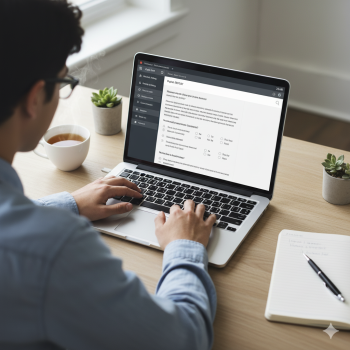Why This Matters: SAT Meets UCAS
If you’re an international student aiming for UK universities, or a parent helping your child navigate the maze of admissions, combining the Digital SAT with the UCAS application can feel like choreographing a complicated dance. Both the SAT and UCAS are pivotal pieces of the puzzle—and when handled well together, they boost clarity, timing, and the strength of an application.

What makes the Digital SAT different — and why that matters for UCAS
The SAT has moved fully digital in many testing regions. This change isn’t just cosmetic; it alters timing, question formats, and how scores are reported. For UCAS, the practical implications are straightforward: universities want evidence of academic readiness, and a clear, up-to-date SAT score is a tangible piece of evidence. Understanding how, when, and which scores to send is key to presenting your strongest profile.
Big Picture Timeline: When to Take the Digital SAT for a UCAS Cycle
Timing is everything. UCAS deadlines typically peak in mid-January for most undergraduate courses, though some competitive courses and early offers may involve earlier deadlines. That means you want reliable SAT results available before or during your UCAS application window so you can list them in your personal statement or provide them to admissions if asked.
Recommended testing schedule
- Junior year (Year 12): Take a diagnostic SAT early to identify strengths and weaknesses. Use this to tailor study through the remainder of the year.
- Summer before final year (between Year 12 and Year 13): Take a first full official Digital SAT. This gives you an official score to reference and time to retake if needed.
- Autumn of final year (Year 13): If you need to improve scores, take one last administration at least 4–6 weeks before UCAS deadline to guarantee scores arrive in time.
Why these windows? The Digital SAT’s score release schedule and the routing of reports take time—plan conservatively so you don’t feel rushed.
Navigating Score Sending: How to Get SAT Scores to UK Universities
Sending SAT scores to UK universities is the same basic process as sending them to U.S. colleges: you select the institutions when you order score reports through your College Board account. However, when you combine this with UCAS, there are a few extra details to think about.
Key practical tips
- Decide early whether to send scores with your initial UCAS application or to submit them later. Some programs accept applications without scores and consider them later; others expect scores at the time of decision.
- Use the College Board code finder to ensure you’re sending to the right campus or admissions office. UK universities may have specific codes for incoming international applicants or particular campuses.
- Remember that some universities consider SATs for scholarship and placement decisions even if their admissions processes are holistic or test-flexible.
How to Present SAT Scores in UCAS Communications
UCAS itself does not have a dedicated field for SAT scores on the main application form the way U.S. systems do. Instead, SAT scores are most often included in:
- Your personal statement (brief mention, when relevant to your academic story)
- Supplementary forms or direct email to admissions (if a university requests standardized test results)
- After you apply—via direct submission to the university’s admissions office using College Board score reports
Think of SAT scores as supporting evidence rather than the centerpiece. Use them to back up claims about readiness for quantitative or analytical work, especially for STEM, economics, or data-driven subjects.
Should You Include SAT Scores? Deciding What Strengthens Your Application
The landscape is nuanced: many UK universities are test-aware rather than test-centric, especially after recent shifts in global testing policy. So how do you decide whether your SAT helps or distracts?
Ask these questions
- Is your score competitive for the programs you’re applying to? If your SAT is clearly strong, it can reinforce academic ability.
- Does the program value quantitative evidence (e.g., engineering, economics, computer science)? If yes, a high SAT math score is helpful.
- Are you relying on other strong evidence—predicted A-levels, IB scores, or extended project work? If other areas are stellar, SATs are extra polish.
Practical Table: When to Take SATs and What to Expect
| Timeframe | Goal | Expected Outcome |
|---|---|---|
| Early Year 12 | Diagnostic test | Identify weak areas; build study plan |
| Summer Year 12 | First official Digital SAT | Obtain official score; consider sending to programs that accept early evidence |
| Autumn Year 13 | Final attempt (if needed) | Finalize scores before UCAS decisions and scholarship reviews |
Preparing Strategically: Study, Practice Tests, and Digital Test Skills
The Digital SAT shifts the playing field: test navigation is different, timing moves faster in some sections, and adaptive elements change how you tailor practice. Combine subject knowledge with digital test skills for the best result.
Effective study strategies
- Mix content review with timed, digital practice tests. Simulate the test environment at least once monthly in the final 3–4 months.
- Focus on weak question types rather than only raw content. For some students, timing and pacing are the biggest score drains.
- Use score reports to identify the most impactful improvements — the College Board’s performance insights can show which question sets cost you the most points.
That’s also where targeted 1-on-1 tutoring becomes a game-changer. Personalized sessions—like those offered through Sparkl’s tutoring—can zero in on your unique pattern of errors, provide tailored practice schedules, and give you strategies for the digital interface.
Crafting the Personal Statement: Weaving SAT Into Your Story
The personal statement is about fit and motivation. If your SAT story strengthens your narrative (for instance, showing quantitative growth or independent preparation), mention it briefly and meaningfully.
Example phrasing
- Weak: “I scored 1500 on the SAT and want to study physics.”
- Better: “Independent SAT preparation sharpened my problem-solving approach and confirmed my interest in applied physics; practicing time-bound, digital simulations improved my analytical speed — skills I’ll bring to university coursework.”
Keep it concise. Your academic record and predicted grades typically carry more weight in the UCAS system, but your SAT can underscore specific competencies.
Logistics: Transcripts, Predicted Grades, and Communication
UK admissions heavily rely on predicted grades and school references. SATs do not replace predicted grades, but they complement them—especially when your grades are borderline for an offer or when universities ask for additional evidence of potential.
Make sure to:
- Ask your school to include any relevant testing context in the reference if you used SATs to demonstrate readiness.
- Keep clear records of when you took tests and when you requested official score reports to be sent to universities.
- Communicate proactively with admissions offices if you plan to submit late SAT scores after filing your UCAS application; many universities accept updated test information prior to final decisions.
Scholarships and Extra Advantages: Where SAT Scores Can Help
Some universities and scholarship committees consider standardized test scores as part of funding decisions or for honors placements. If you’re applying to programs that award merit-based scholarships to international students, a strong SAT can strengthen your eligibility.
Practical approach
- Research institution-specific scholarship criteria early; include SATs when they explicitly request standardized test evidence.
- Use high SAT subject-specific performance to support applications to competitive majors, especially those that value quantitative assessment.
Common Scenarios and How to Handle Them
Scenario 1: Strong predicted A-levels but no SAT score yet
Don’t panic. Many UK applicants never take SATs. If you’re confident in strong predicted grades, focus on submitting a compelling personal statement and a strong reference. If you still want to submit an SAT later, coordinate with the university admissions office.
Scenario 2: SAT score is stronger than predicted grades
Use the SAT to demonstrate potential. Submit official score reports to the university and ask your counselor to highlight the SAT as supplemental evidence in the reference.
Scenario 3: Planning both APs/IB and the SAT
View the SAT as complementary to coursework and qualifications. AP/IB results and predicted scores are central to UCAS, but SATs add a standardized benchmark across international systems.
How Personalized Tutoring Fits In
Personalized tutoring can reduce uncertainty and accelerate improvement. Tutors who understand both the Digital SAT format and the UK admissions context can help you prioritize: whether to strengthen SAT scores, refine your personal statement, or plan timing to fit UCAS deadlines.
Sparkl’s personalized tutoring approach — 1-on-1 guidance, tailored study plans, expert tutors, and AI-driven insights — can be particularly helpful for students balancing UK curricular demands with standardized test prep. Tutors can create practice schedules aligned with school calendars, simulate the digital environment, and coach you on how to present test scores within your UCAS narrative.
Checklist: Combining SAT with UCAS — Final Action Steps
- Create a master calendar with UCAS deadlines, SAT test dates, and score release windows.
- Take a diagnostic Digital SAT early to shape study priorities.
- Decide whether to send initial scores with your application or submit them later—note each university’s policy.
- Use school references to contextualize SAT performance if the score is a central piece of your case.
- Practice the digital format often—timed, adaptive practice is essential.
- Consider targeted 1-on-1 tutoring for efficient gains, especially if balancing heavy school workload.
Real-World Example: One Student’s Path
Emma, a student in Year 13 applying for Economics, took a diagnostic Digital SAT in March and discovered timing in the Math section was her biggest issue. She used a focused study plan: content review twice a week, and digital mock tests every fortnight. She took an official Digital SAT in July, then another in October after two months of targeted tutoring. Her October score was the one she sent to her selected UK universities before their decision deadlines. In her personal statement she briefly tied her SAT preparation to a project where she used statistical tools to analyze local economic indicators—turning a score into a story about initiative and skill.
Common Questions from Parents
Q: Do UK universities prefer one testing system over another?
A: No single preference exists. Admissions teams look at the whole profile—predicted grades, personal statement, references, and sometimes test scores. SATs are another piece of evidence, particularly useful for international applicants.
Q: If my child’s school offers in-school SAT testing, should they use that?
A: Yes—if the logistics align with your timeline. In-school testing can make access easier and often links directly to the BigFuture School app for score access and planning resources.
Wrapping Up: A Calm, Strategic Approach
Combining the Digital SAT with a UCAS application doesn’t have to be stressful. With a sensible timeline, realistic practice, and a clear strategy for submitting scores, you can turn tests into advantages rather than pressure points. Keep the narrative authentic: use SATs to complement, not replace, your academic story.
Finally, remember that help is available. Whether you choose individualized tutoring, structured courses, or self-study with smart practice, it’s the steady, targeted effort that pays off. If you’re looking for tailored 1-on-1 guidance that considers both Digital SAT demands and UCAS timing, services like Sparkl’s personalized tutoring can provide that strategic, student-centered support that makes the journey smoother.

Want a Quick Plan to Get Started?
Use this 6-week starter plan if you’re beginning SAT prep in the middle of your application timeline:
- Week 1: Take a timed digital practice test and analyze results. Identify top three areas to improve.
- Week 2–3: Focused content drills (Math fundamentals; Evidence-based Reading strategies). Two timed sections per week.
- Week 4: Full digital practice test under simulated conditions; review mistakes and timing.
- Week 5: Targeted practice on weakest question types; work on pacing strategies.
- Week 6: Final full test; prepare official score submission and confirm UCAS timeline alignment.
Need more time? Stretch the plan across 12 weeks and add regular tutor check-ins. Personalized tutoring can compress progress by focusing practice where it matters most.
Final Thoughts for Parents and Students
This process is less about chasing a single number and more about building a coherent, authentic application that shows readiness and potential. The Digital SAT is a tool—use it where it strengthens the story you’re telling to UK universities. Keep communication open with school counselors, map your dates meticulously, and use practice intelligently. With careful planning and the right support, your SAT and UCAS efforts will complement each other and present a confident, compelling application.
Good luck—and remember: steady, strategic preparation beats last-minute pressure every time.













No Comments
Leave a comment Cancel